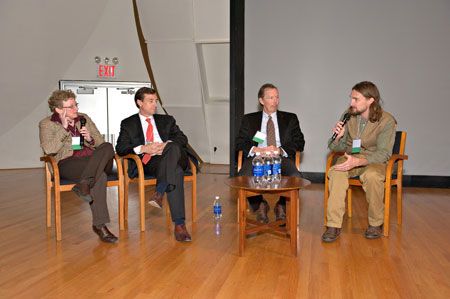Conference calls for collaboration between human and veterinary doctors
Organizers hope conference will encourage translational medical programs

Dr. Joan Coates, Dr. Dale Lange, Dr. Ralph Nixon and Dr. Chad West discuss neurodegenerative and cognitive disorders in humans and animals.
(Photo courtesy of The 2013 Zoobiquity Conference.)
Veterinary and human medical professionals met Nov. 2 at the Zoobiquity conference in New York City to discuss similar diseases in humans and animals. A team, comprised of veterinary and human doctors, tackled specific cross-species diseases during a morning presentation of a half-dozen translational cases. The result was a reflection of the book the conference was born from: Zoobiquity: What Animals Can Teach Us About Health and the Science of Healing.
The hope of conference organizers is to provide a forum for animal and human medical professionals to exchange ideas and encourage academic and clinical training programs to offer comparative medicine education, says Barbara Natterson-Horowitz, MD, author of Zoobiquity and physician at UCLA.
“We envision a future where specialists remain separate but veterinary and medical students study and train alongside one another and where faculty members from these disciplines develop core curriculum based on ‘zoobiquitous’ approaches to health. Perhaps in a few years, there will be degree programs such as a DVM/MD joint degree for those who want to work across both sides of the species divide. Of course, programs exist around the country and world that, for years, have taken a comparative approach.”
Natterson-Horowitz and her co-author, Kathryn Bowers, were on hand as members of the team of experts discussed how individual research they’ve done could benefit their medical counterparts and took questions from the audience. Dee McAloose, VMD, DACVP and Larry Norton, MD, discussed the similarities of invasive mammary carcinoma in a captive Amur tiger and breast cancer in post-menopausal women. An audience member asked why mammograms weren’t regularly performed on animals. Other teams touched on other issues such as obesity within an 8-year-old female beagle and a 34-year-old female hospital administrator.
Conference participants were also invited to the Bronx Zoo where diseases in zoo animals were discussed by veterinarians at the zoo and medical doctors. Conference goers were also given a tour of the zoo’s wildlife health center to see how and where zoo animals are treated.
“Having a platform like the 2013 Zoobiquity Conference raises the profile of existing collaborative efforts between veterinarians and physicians—and more importantly, stimulates a dialogue for future collaborations,” says Richard Goldstein, DVM, chief medical officer at the Animal Medical Center in New York City. “This type of partnership is important for veterinary medicine especially as it applies to the clinical research arena and it will ultimately benefit all species.”
The conference pulled in more than 200 attendees for its first appearance on the East Coast. For more information on the next Zoobiquity conference, go to Zoobiquity.com.